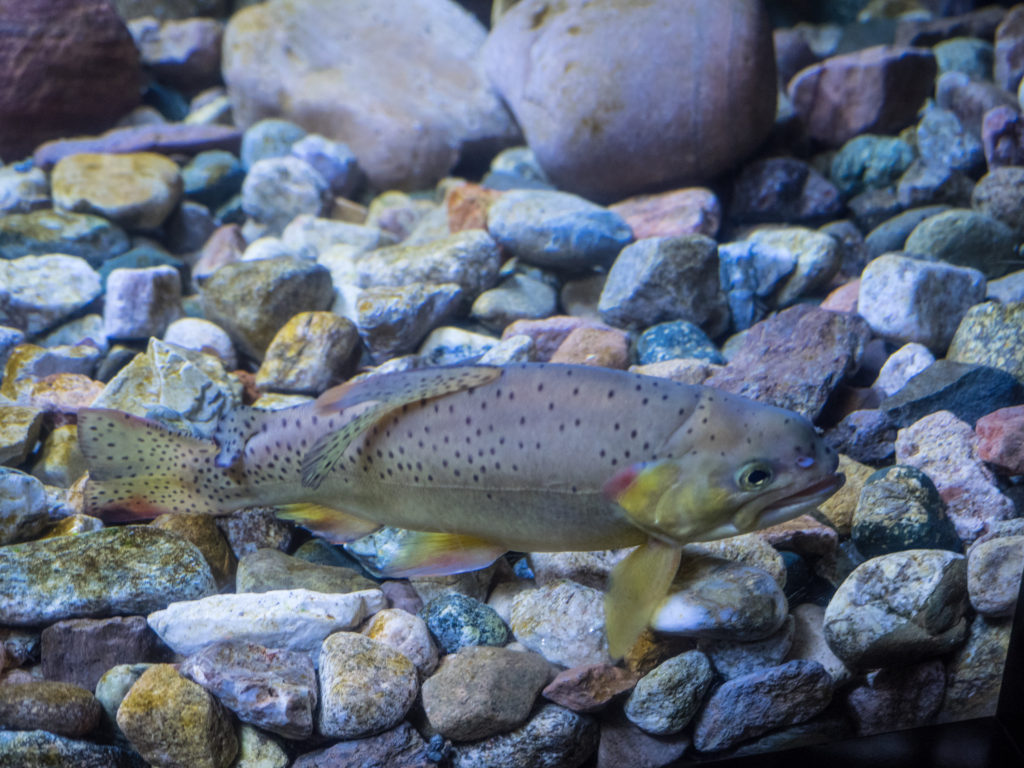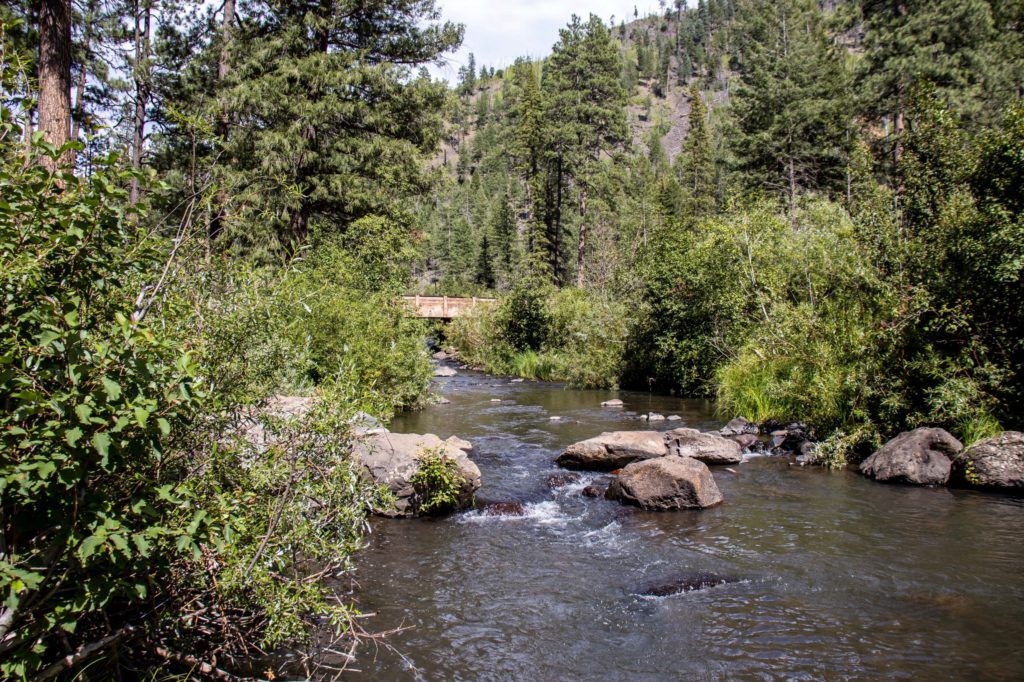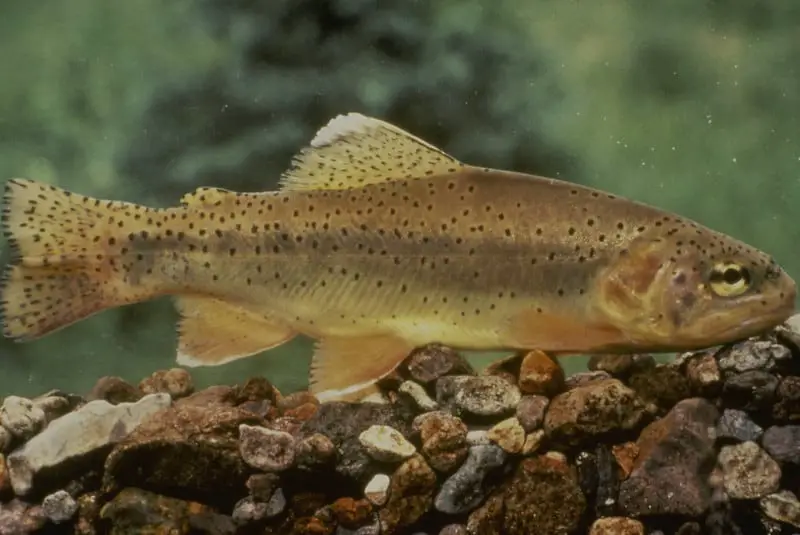In this article, you’ll learn all about Apache Trout. You’ll learn about their Characteristics, environmental challenges, recent history, and where you can fish for Apache Trout today.
Characteristics
Depending on habitat and food availability, Mature Apache Trout range in length from six to twenty-four inches. Ten inches is the approximate average length.
They are yellowish gold in color with olive green on their backs and upper sides. Their bellies are gold in color. Apaches also have evenly spaced dark spots that may extend below the lateral line and onto the dorsal and tail fins.
Additionally, they have olive-green heads and have the appearance of having a black stripe/mask through each of their eyes due to two small black dots on either side of the pupil. They also may have a cutthroat-like throat mark below the lower jaw, ranging in color from yellow to gold.
The World record Apache Trout was taken from Hurricane Lake on the White Mountain Apache Reservation in 1993. It measured 24 inches and weighed 5 pounds, 15 and a half ounces.
Some Quick Facts
The Apache Trout is one of two trout species native to the state of Arizona. The other is the Gila Trout.
In 1986 The State of Arizona named the Apache Trout its state fish because it is found nowhere else in the World.
When one thinks of Arizona, it conjures up visions of sand and Saguaro cactuses, but Apache Trout are native to more alpine-like settings. They live in the cold-water streams of the White Mountains in eastern Arizona. More specifically, they’re native to the headwaters of the White, Black, and Little Colorado Rivers, primarily above 6000 feet. Instead of sand and cacti, Apache trout country is primarily mixed conifer and Ponderosa Pine forests.
Apache Trout were once so numerous that early settlers harvested them and salted their meat for winter storage.
Today Apache Trout are Federally listed as a threatened species and inhabit only 170 of their former habitat’s estimated 820 miles.

Threats to Apache Trout
Once upon a time, the Apache Trout population in Arizona’s White Mountains thrived. There are photos and accounts from the late 1800s where settlers harvested hundreds of Apache trout in a single outing.
Non Native Trout
The first Rainbow Trout was stocked in Arizona in 1898. This was a harbinger of troubled times on the horizon For the Apache Trout. In the early 1900s, Arizona’s population was rapidly increasing. A growing population placed new demands on Arizona’s fishery.
To address the overfishing of native trout, state and federal agencies began stocking nonnative trout species in Apache Trout streams. The effects were disastrous.
Despite the good intentions, these supplemental stockings were one factor that drove Apache Trout to the brink of extinction. Rainbow, Brook, Cutthroat, and Brown trout out-compete Apache trout for limited food and cover and prey upon their young. Rainbow and Cutthroat trout are also sufficiently genetically similar to Apache Trout that they can cross-breed with them, creating hybrids and diluting the purity of their gene pool.
Human Activities That degrade Habitat
Unregulated livestock grazing in riparian zones, timber harvesting, road building, and other land uses also adversely affected the Apache Trout’s Coldwater stream environment.
These land-use practices removed or greatly reduced the presence of sedges, grasses, and willows along stream banks, ultimately leading to increased soil load due to erosion, widened stream beds, increased water temperatures, clogged gravel beds, which these fish need for spawning, and generally degraded habitat.
Reservoir construction for irrigation, recreation, and flood control altered streamflow patterns and created artificial barriers to natural fish migration.
Forest Fires
Forest fires have in the distant and recent past wiped out entire populations of Apache Trout. The fire-burned mountain slopes stripped of vegetation have no way to hold back rainwater. When there’s a significant storm after a fire, water will rush into streams carrying silt, debris, and ash. The ash is particularly devastating. For example, in 2011, the Wallow fire removed fish populations from entire streams in Arizona’s White Mountains.
Almost Gone
Apache Trout once ranged over an estimated 820 stream miles in the high-elevation headwaters of the Black, White, and Little Colorado Rivers in the White Mountains of eastern Arizona. By the mid-1950s, Apache trout populations were confined to just 30 stream miles or just under 4% of their original native territory.
By the 1950s, the last known Apache Trout populations existed on the White Mountain Apache Reservation.
Recovery
In 1955 the White Mountain Apache tribe closed all reservation waters that contained Apache Trout to fishing. This was a crucial first step in bringing these fish back from the brink of extinction. Interest in Apache trout substantially increased during the early 1960s, resulting in fishery surveys carried out by the U.S. Fish and Wildlife Service (USFWS) and Arizona Game and Fish Department in cooperation with White Mountain Apache Tribe to determine species status. In conjunction with these surveys, the aforementioned entities entered into a propagation and stocking program. [7]Apache Trout were stocked into streams beginning in 1963
Removal Of Non Native Species
Starting in the early 1960s, barriers were constructed on several streams to prevent nonnative trout from migrating upstream into areas designated for Apache Trout recovery. Also, at this time, all the nonnative trout species were removed from several streams. Pure Apache Trout were stocked in their place.
In 1966 Congress passed the Federal Endangered Species Preservation Act. Apache Trout was listed as endangered. Apache trout became federally protected with the passage of the more stringent Endangered Species Act in 1973.
After reevaluation in 1975, the Apache trout was one of the first species downgraded from endangered to threatened. Being listed as threatened includes a provision that allows for selective sport fishing.
Renovation of Habitat
Between then and now, a lot of progress has been made in the renovation of degraded habitats. This includes but is not exclusive to erecting fencing to keep livestock out of sensitive riparian areas.
Fisheries personnel have erected more fish barriers to keep selected waters exclusive to the Apache Trout. Additionally, they have removed Non-native species from certain areas.
Efforts are ongoing. As earlier stated, Apache Trout currently occupy an estimated 170 stream miles of their former range. 170 isn’t as good as 820, but it’s a far cry from 30.
As I stated earlier, the Apache Trout is federally listed as threatened instead of endangered. With a threatened listing, limited sport fishing is allowed.
Places to catch Apache Trout
In Arizona State Waters
A state fishing license and trout stamp are required.
Lee Valley Reservoir
Lee Valley Reservoir is located in Apache County, Arizona, in the Apache-Sitgreaves National Forest near Mount Baldy. This lake’s elevation is 9,420 feet. Consequently, there’s often no access in the winter due to snow.
Lee Valley Reservoir holds Apache Trout and Arctic Grayling.

East Fork of the Black River
The East Fork of the Black River lies on the Apache-Sitgreaves National Forest. It offers fishing for Rainbow Trout, Brown Trout, and Apache Trout.
West Fork of the Black River
The West Fork of the Black River holds both Brown and Apache Trout. To those looking for Apache Trout, the Arizona Game and Fish Department recommends two different sections.
The first one is near the West Fork campground. The second one is in the vicinity of Big Lake.
West Fork Of The Little Colorado River
During the fishing season, the AZGFD stocks the West Fork of the Little Colorado River at Sheeps Crossing weekly with Apache Trout.
The AZGFD also regularly stocks Apache Trout in the West Fork of Little Colorado in the vicinity of Greer.
Silver Creek is a 45 mile long tributary of the Little Colorado River. Its upper stretches are a clear, cold spring-fed creek—the AZGFD stock Silver Creek with Rainbow and Apache Trout.
The only tackle allowed is artificial flies and lures with single-pointed barbless hooks. Fishing is catch and release only.
There is a fish hatchery along Silver Creek that produces all the Apache Trout stocked in Arizona.
White Mountain Apache Waters
A tribal fishing permit is required.
Hawley Lake
Hawley Lake is 260 acres in size. Along with Apache trout, it has Cutthroat, Brown, and Brook trout.
Pacheta Lake
Pacheta Lake is Catch-and-Release. Artificial lures and flies with single barbless hooks only.
Christmas Tree Lake
Christmas Tree Lake is fish by reservation only. There is a limit of twenty anglers per day. Call (928)369-7669 to make a reservation
Bog Tank
Along with Apache Trout, Bog Tank also has Brown Trout, Cutthroat Trout, and Rainbow trout.
Hurricane Lake
The world record Apache trout was caught in Hurricane Lake in 1993. Hurricane lake is currently closed as of 11/12/2020.
Shus Be Tou & Shus Be Zahze
Along with Apache Trout, these Lakes also hold Brown, Brook, and Rainbow Trout.
Earl Park Lake
Along with Apache Trout, Earl Park Lake also has brook, rainbow, brown, and cutthroat trout.
Horseshoe Lake
Horseshoe Lake has Rainbows and Browns along with Apache Trout.
Sunrise Lake
Along with Apache Trout, Sunrise Lake has Brook and Rainbow Trout.
White Mountain Apache Reservation Fishing Regulations
“Daily bag limits for trout: 15 & older is 5 fish a day; 10-14 year old is 3 fish a day; 9 & younger is 2 fish a day. A valid White Mountain Apache Tribal Permit is required. It must be carried at all times when fishing, boating, camping, and for all outdoor recreation activities on the Fort Apache Indian Reservation. Permits can be obtained at permit vendors located on and off the reservation. Visit our website at www.wmatoutdoor.org or call our office at (928)338-4385 for the fishing report.“
I hope you find the time and have the opportunity to catch some Apache Trout.
If you do, you’ll be somewhere out in Arizona’s White Mountains, which is the only place on earth that they exist. Life’s all too short. Make sure you see some of the best places on earth before it is done.
Recent Posts
The only venomous snakes in Washington State are Northern Pacific Rattlesnakes. The Northern Pacific Rattlesnake (Crotalus oreganus oreganus) is a sub-species of the Western Rattlesnake. Anyone...
Skunks are not classified as true hibernators. But they go into a state of torpor when the weather gets cold. Skunks are light sleep hibernators, along with opossums, bears, and raccoons. ...

